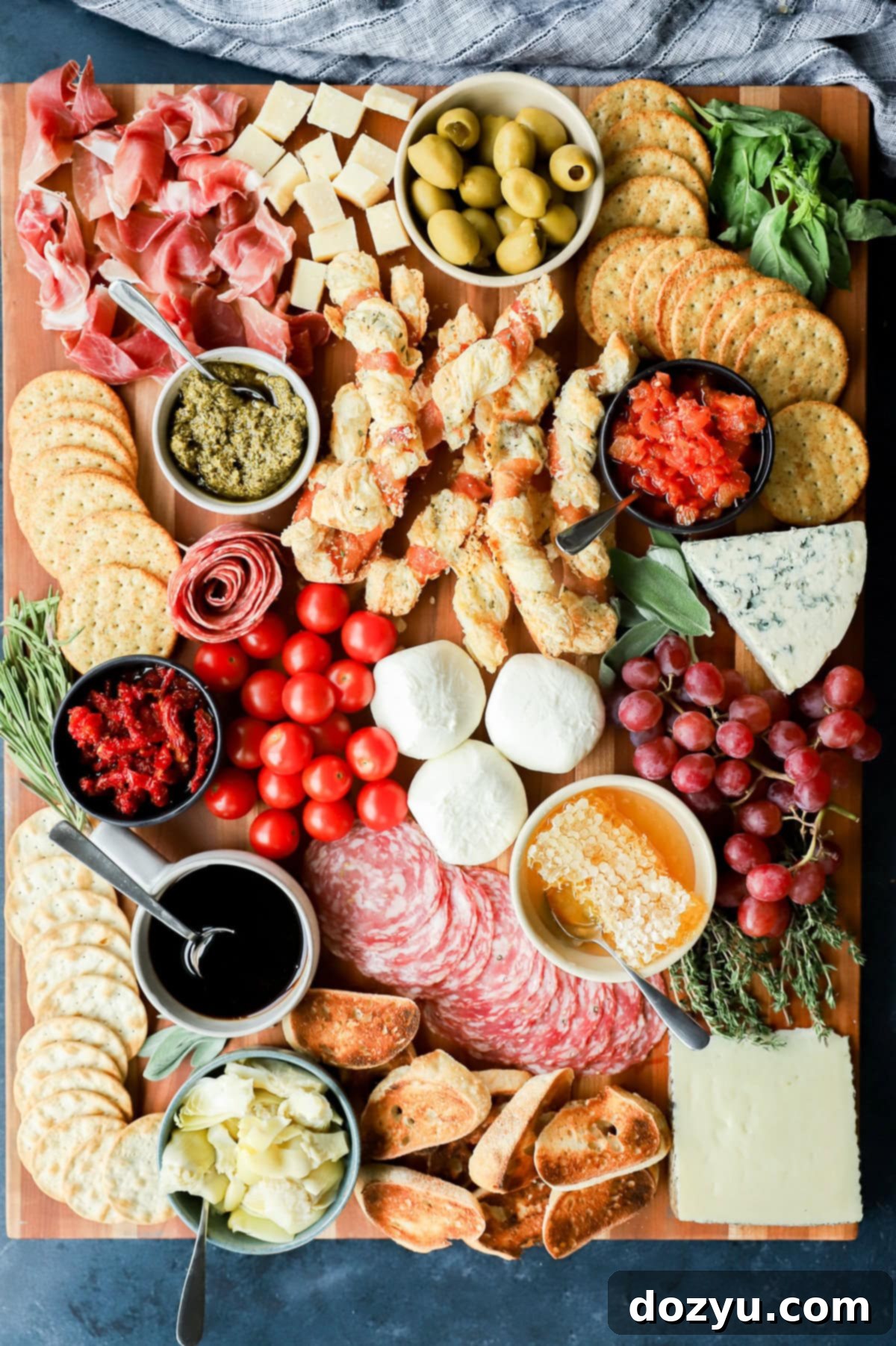Ultimate Italian Charcuterie Board: Crafting the Perfect Antipasto Platter
Embark on a culinary journey to Italy right from your kitchen by building the ultimate Italian charcuterie board. Featuring an exquisite selection of prosciutto, premium salami, fresh mozzarella, and a curated assortment of classic Mediterranean delights, this guide shares our top tips for choosing the finest meats, cheeses, and irresistible pairings. Get ready to create a stunning appetizer spread that will impress every guest.
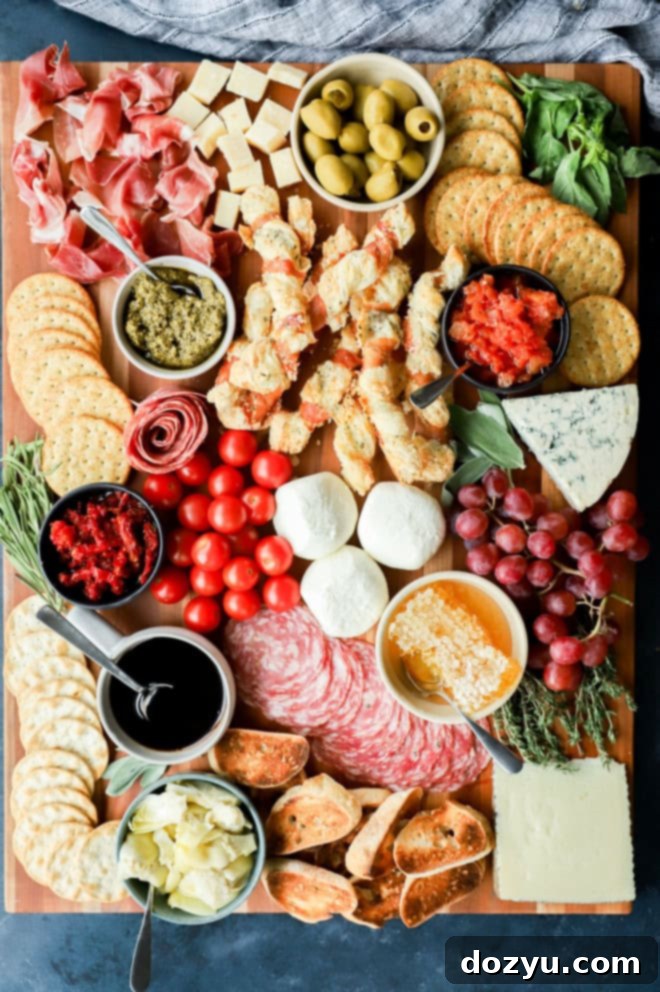
Table of Contents
Toggle
About This Italian Charcuterie Board
Forget the stress of cooking and effortlessly create a magnificent Italian charcuterie board that promises to transport your guests straight to a charming Roman wine bar or a bustling piazza. This artfully arranged platter is generously loaded with an array of premium cured meats, authentic regional cheeses, briny olives, and wonderfully marinated vegetables, all coming together to celebrate Italy’s most iconic and beloved flavors.
The secret to an truly exceptional Italian board lies in two core principles: sourcing high-quality ingredients and mastering the art of thoughtful pairing. It’s about achieving a harmonious balance of flavors and textures—think sweet figs complementing salty prosciutto, creamy burrata alongside crunchy crostini, or a hint of spicy salami cut by fresh fruit. The greater the variety and contrast, the more delighted your guests will be as they discover new combinations and craft their own perfect bites.
This versatile board is ideal for any occasion, from intimate wine nights with close friends to larger, festive gatherings during the holiday season. Serve it as an impressive pre-dinner appetizer, or let it take center stage as the star of your traditional Italian aperitivo hour. The best part? Very minimal cooking is required (unless you choose to add a warm element!) – it’s primarily about thoughtful selection, artful arrangement, and a little bit of enjoyable prep work. It’s an easy yet elegant way to entertain.
For even more inspiration and answers to all your pressing questions, explore our comprehensive collection of cheese board ideas!
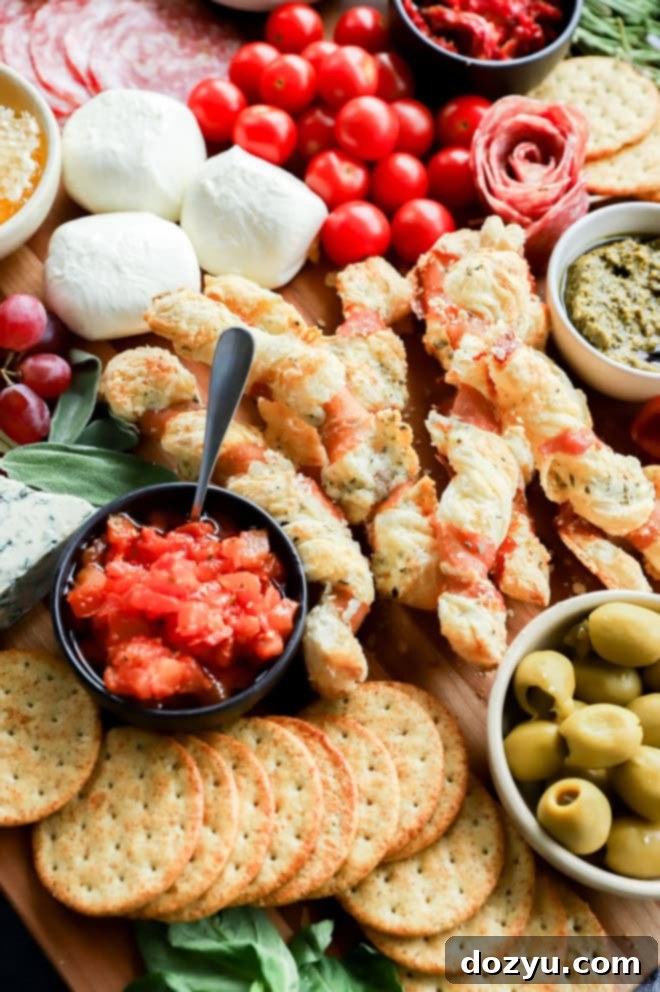
What is an Italian Charcuterie Board?
The term “charcuterie” originates from French culinary traditions, referring to a branch of cooking dedicated to preparing and preserving meats, such as pâtés, terrines, gallantines, and sausages. While historically French, the concept of a “charcuterie board” has beautifully evolved globally, especially within Italian cuisine, where it transforms into a vibrant celebration of *antipasto*.
An Italian charcuterie board, often referred to as an “antipasto platter” (antipasto meaning “before the meal”), goes beyond just cured meats. It’s a comprehensive spread designed to awaken the palate before the main course. It traditionally features an assortment of classic Italian cured meats like prosciutto and salami, but significantly expands to include a rich variety of Italian cheeses, a medley of olives, seasonal fruits, marinated vegetables, and often flavorful dips or spreads.
These Italian-style boards serve as perfect pre-dinner Italian appetizers, inviting guests to leisurely graze and socialize. They are also magnificent centerpieces for any gathering, fostering a convivial atmosphere. By bringing together Italy’s finest flavors – from savory and salty to sweet and tangy – in a visually stunning and interactive display, an Italian charcuterie board truly embodies the spirit of Italian hospitality and good food.
Types of Cheese for an Italian Charcuterie Board
Selecting the right variety of cheeses is paramount to a successful Italian charcuterie board. Aim for a mix of textures and flavor profiles to offer a delightful journey for your guests. Here’s a breakdown of essential cheese categories and excellent Italian choices:
- Hard Cheese: A high-quality aged cheese provides a fantastic salty and nutty anchor for your board.
- Parmigiano-Reggiano: This “King of Cheeses” is a must-have. Its granular texture and deeply savory, umami flavor, with notes of toasted nuts and fruit, are unmistakable. Serve in rustic chunks or thin shavings.
- Aged Pecorino Romano: For a sharper, saltier kick, try this sheep’s milk cheese. It offers a more pungent, piquant flavor compared to Parmigiano.
- Manchego: While technically Spanish, an aged Manchego is also an excellent choice, known for its buttery, tangy flavor that pairs beautifully with honey and marcona almonds.
- Fresh Cheese: These cheeses bring a refreshing creaminess and often a mild, milky flavor that balances stronger elements.
- Burrata: An absolute showstopper! This fresh Italian cheese, made from mozzarella and cream, has an outer shell of solid mozzarella and a soft, creamy interior. Drizzle generously with high-quality olive oil and a sprinkle of cracked black pepper or flaky sea salt.
- Marinated Mozzarella Balls (Bocconcini or Ciliegine): Small, fresh mozzarella balls marinated in herbs, garlic, and olive oil add an incredible burst of flavor and a lovely soft texture. They’re easy to pick up and enjoy.
- Soft Cheese: Soft cheeses contribute a delightful, spreadable texture and often a milder, more approachable flavor.
- Taleggio: A fantastic soft Italian cheese with a relatively mild, fruity, and slightly tangy flavor, often described as buttery and earthy. It has a sticky, reddish-orange rind and a wonderfully creamy interior.
- Whipped Ricotta: For an unexpected and incredibly delicious addition, serve a bowl of freshly whipped ricotta. Drizzle it with honey, a pinch of chili flakes, or a sprinkle of fresh herbs. It’s light, airy, and utterly divine.
- Brie: While French, a good Brie can certainly find a place on an Italian-themed board if it’s a crowd-pleaser and you enjoy its creamy, mild profile. Remember, it’s all about crafting a board you and your guests will savor!
- Funky/Blue Cheese: A small addition of a blue cheese can add depth and an exciting flavor contrast.
- Gorgonzola: This famous Italian blue cheese offers the perfect amount of bold, tangy, and slightly spicy flavor without overwhelming the entire board. It comes in two main varieties: Dolce (sweeter, creamier) and Piccante (firmer, sharper). Both pair beautifully with figs, honey, and a glass of red wine.
Aim to include 3-4 different types of cheese, ensuring a variety of hardness, flavor intensity, and milk type (cow, sheep, buffalo) for the most diverse and enjoyable experience.
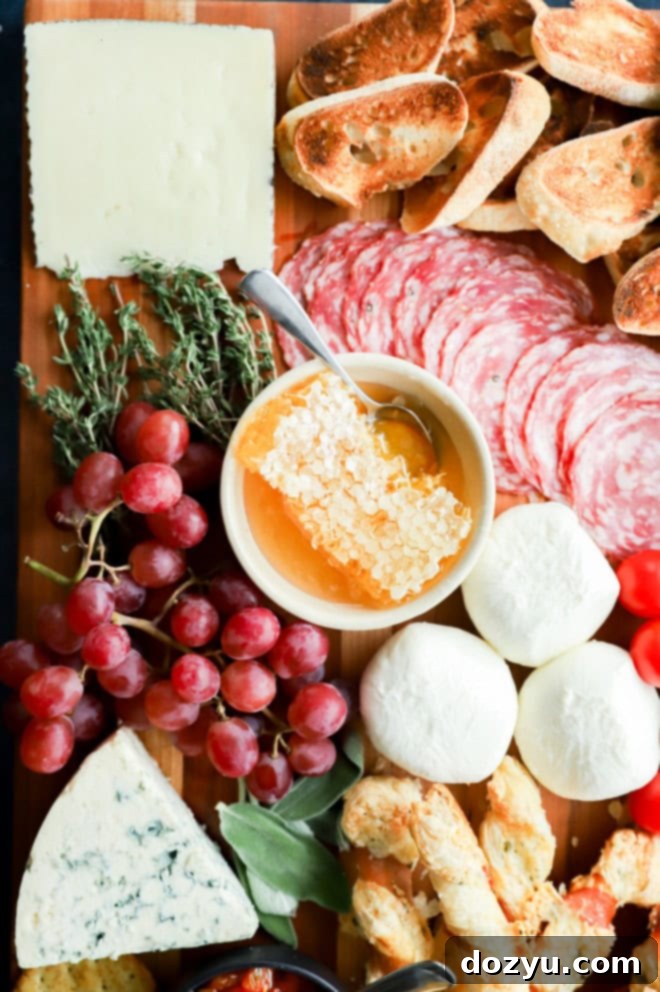
Here’s What You’ll Need for Your Italian Charcuterie Board
Creating an impressive Italian charcuterie board is all about selecting a diverse range of high-quality ingredients that offer a variety of flavors, textures, and visual appeal. Here’s a comprehensive list to guide your shopping and assembly:
- Cheeses (Select 3-4 varieties): Aim for a balance of textures and flavors.
- Fresh: Burrata or small marinated mozzarella balls (bocconcini or ciliegine) offer creamy, milky notes.
- Hard & Aged: Parmigiano-Reggiano, Aged Pecorino Romano, or an aged Manchego for salty, nutty, and savory depth.
- Soft & Creamy: Taleggio for its buttery texture, or homemade whipped ricotta with honey for a light, sweet contrast.
- Bold & Funky: A wedge of Gorgonzola (either dolce or piccante) to introduce a pungent, tangy kick.
- Meats (Select 3-4 varieties): Provide a mix of textures and spice levels.
- Prosciutto: Thinly sliced, delicate, and salty. Look for Prosciutto di Parma or San Daniele. Fold into elegant ribbons.
- Salami: Offer variety with spicy Calabrese salami, classic Genovese, or mild Felino. Slice thinly or fold into quarters.
- Soppressata: A dryer, more robust salami, often with a coarse texture and peppery notes.
- Mortadella: A delicately flavored, large Italian sausage, often studded with pistachios. Offers a different, softer texture.
- Speck: A smoked, cured ham from Alto Adige, offering a distinct smoky flavor profile.
- Coppa (Capicola): A cured pork shoulder or neck, known for its beautiful marbling and rich, slightly spicy flavor.
- Optional: Crispy Prosciutto Chips: For an extra crunch, bake thin slices of prosciutto until crispy.
- Crackers & Bread (Offer 2-3 options): Essential vehicles for your meats and cheeses.
- Crusty Italian Bread: A freshly baked baguette, sliced, or rustic Italian loaf provides a substantial base.
- Crostini: Small, toasted bread slices perfect for piling toppings.
- Grissini Breadsticks: Elegant and crunchy, ideal for wrapping with prosciutto.
- Crispy Crackers: A neutral cracker allows the other flavors to shine.
- Taralli: Small, crunchy Italian ring-shaped crackers, often savory and sometimes flavored.
- Focaccia Crisps: Thin, airy, and flavorful, offering an authentic Italian crunch.
- Homemade Touch: Consider prosciutto cheese twists for a unique homemade element.
- Fresh Elements: Add color, acidity, sweetness, and freshness.
- Seasonal Fruits: Figs (fresh or dried), red or green grapes, sliced pears, apple wedges, and berries. Their sweetness beautifully contrasts salty meats.
- Cherry Tomatoes: Halved or whole, they provide a juicy pop of freshness and vibrant color.
- Marinated Vegetables: Artichoke hearts (marinated), roasted red peppers, sun-dried tomatoes (oil-packed), and green or black olives (e.g., Castelvetrano, Kalamata) are classic Italian additions.
- Cucumber or Bell Pepper Strips: For a refreshing crunch.
- Extras & Condiments: These elevate the experience, offering additional flavor dimensions.
- Olives: A selection of pitted and unpitted olives in varying brines and flavors.
- Fig Jam or Fruit Preserves: Sweetness to balance savory meats and cheeses.
- Honey or Honeycomb: A natural sweetener that pairs perfectly with hard and blue cheeses.
- Marcona Almonds: Delicately roasted and salted, or other favorite nuts like pistachios or walnuts.
- Bruschetta Mixture: A fresh tomato and basil topping.
- Basil Pesto Sauce: A vibrant, herbaceous dip.
- Balsamic Glaze: A sweet and tangy drizzle for cheeses or fruits.
- Fresh Herbs: Basil, sage, rosemary, oregano, thyme sprigs for decoration and aroma.
- Dried Fruits: Apricots, cranberries, or dates for added sweetness and chewiness.
Essential Tools & Tips for Assembly
To ensure your Italian charcuterie board is both beautiful and functional, a few essential tools and preparation steps are key. First and foremost, you’ll need a suitable serving vessel. A large wooden cutting board, a slate platter, or a beautiful serving tray works perfectly, providing ample space for all your delicious components. The larger the board, the more lavish your spread will appear, making it an inviting focal point.
Before you begin the artistic arrangement on your main serving board, it’s crucial to prepare all your ingredients. This means slicing all your meats and cheeses on a separate cutting board. Use a sharp chef’s knife or a specialized cheese knife for clean, even cuts. Pre-slicing ensures ease of serving for your guests and allows you to focus solely on the aesthetics during assembly. Remember, a well-prepped mise en place makes the assembly process smooth and enjoyable, rather than rushed.
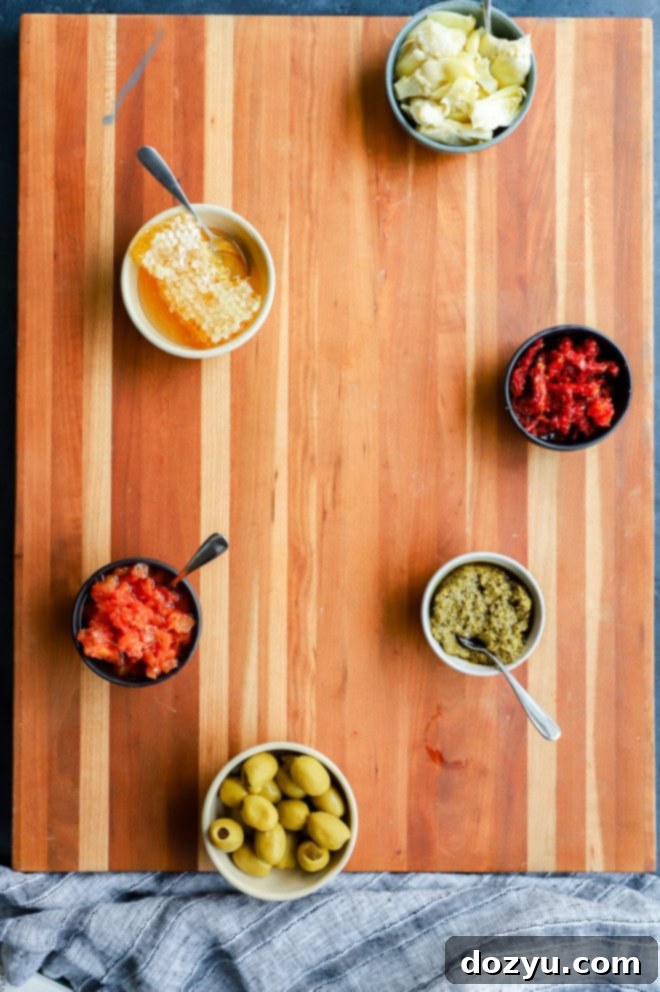
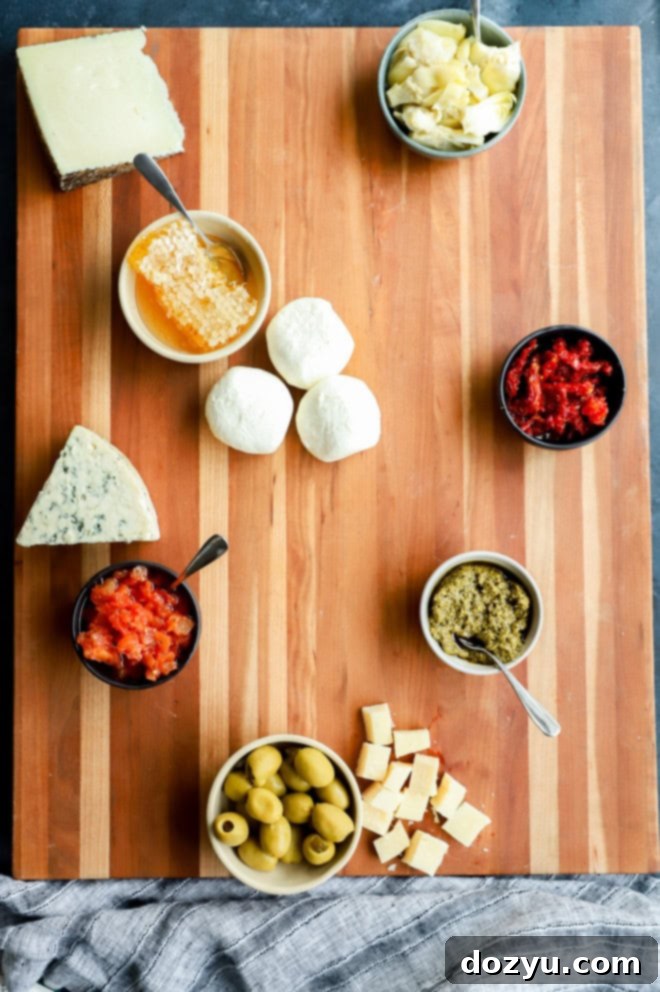
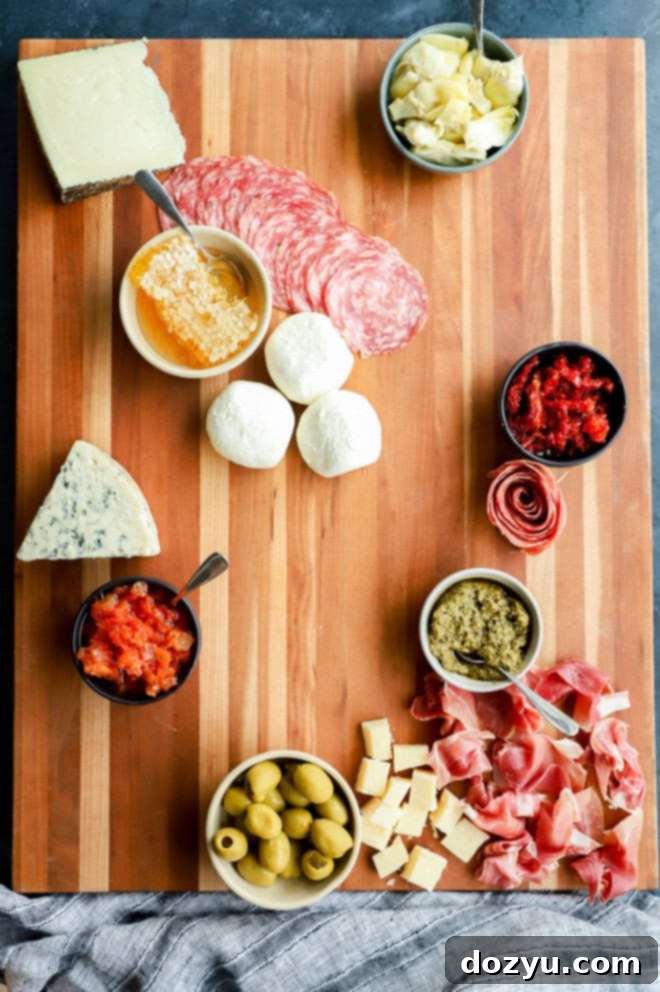
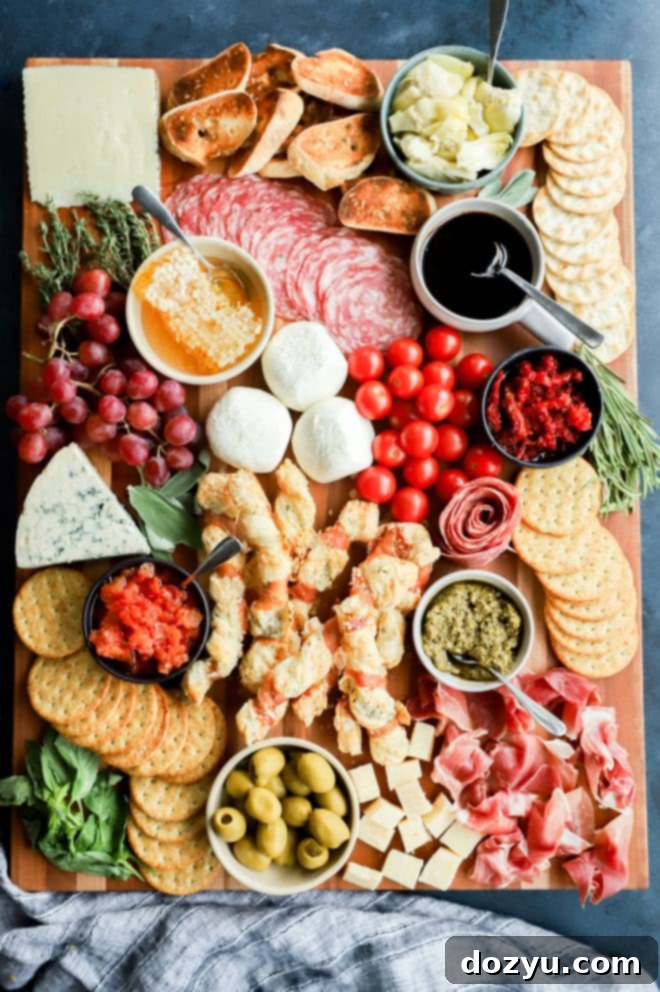
How to Assemble an Italian Charcuterie Board
Assembling a charcuterie board is an art form, but it doesn’t have to be intimidating. By following these simple steps, you’ll create a visually stunning and incredibly inviting spread every time. The key is to build in layers, starting with your anchor pieces and filling in around them.
Add Bowls First
Begin by placing your small bowls strategically on your main serving board. These bowls serve as the anchors of your design and make it much easier to arrange the rest of the elements around them. Fill each bowl with items that are either wet (like olives, marinated artichoke hearts, or pesto) or those that need to be contained (like jams, honey, or nuts). Space them evenly across the board to create distinct zones for building your layout. Don’t forget to add small spoons or spreaders to each bowl for easy serving and to prevent cross-contamination.
Strategically Add Meats
Once your bowls are in place, it’s time to artfully arrange your cured meats. Think about creating visual interest by using different folding and layering techniques. For example, fold thinly sliced prosciutto into loose, elegant ribbons or pleat them onto skewers. Fan out salami slices, create charming “salami roses,” or simply layer them in overlapping rows. Distribute different types of meats evenly across the board, tucking them around the bowls and cheeses to build texture and color. This thoughtful placement is absolutely key to making a gorgeous and abundant spread!
Arrange Cheeses Beautifully
Before placing your cheeses on the board, ensure each variety is prepped for easy enjoyment. Slice hard cheeses like Parmigiano-Reggiano into rustic chunks or thin wedges. Crumble softer blue cheeses like Gorgonzola into small, accessible pieces. For semi-hard or soft cheeses like Taleggio, cut them into manageable squares or triangles. If you’re including a large wedge of cheese, pre-cut a few slices and provide a dedicated cheese knife nearby for guests to serve themselves. Arrange the cheeses in different areas, ensuring they are near complementary meats, fruits, or crackers.
Incorporate Fresh Elements
Now, add the vibrant fresh elements, bringing an assortment of fruits and vegetables to life on your board. Layer sliced apples, pears, and seasonal berries in beautiful formations between your meats and cheeses. Create neat rows of thinly sliced fruit that fit perfectly on crackers, or pile fresh produce like juicy cherry tomatoes and colorful bell pepper strips into any empty spaces. The goal here is to add pops of color, refreshing flavors, and healthy components that cut through the richness of the meats and cheeses.
Fill in with Extras
Finally, it’s time to complete your masterpiece by filling in all the remaining gaps with your chosen extras. This includes items like crunchy marcona almonds, sun-dried tomatoes, additional crackers, or any other delicious morsels that didn’t fit into the previous categories. These small additions not only make the board look incredibly abundant and inviting but also provide endless pairing possibilities for your guests. Don’t forget to tuck in fresh herb sprigs like basil or rosemary for a beautiful, aromatic garnish that enhances the Italian theme.
More easy board ideas to try: Fall Charcuterie Board | Fruit Charcuterie Board | Breakfast Charcuterie Board | Summer Charcuterie Board | Easy Charcuterie Board
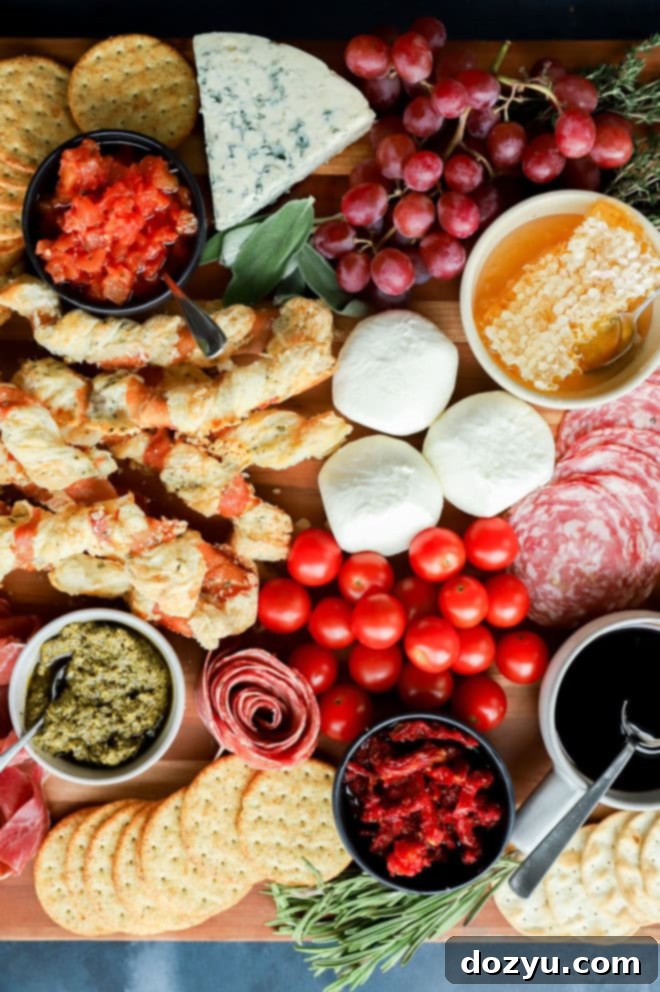
How Long Can an Italian Charcuterie Board Sit Out?
For optimal flavor and food safety, it’s best to serve your Italian charcuterie board with the meats and cheeses brought to room temperature for about 30 minutes before serving. This allows the complex flavors of the cheeses and the delicate textures of the cured meats to truly shine. However, this doesn’t mean the board can sit out indefinitely.
To ensure food safety, particularly for perishable items like cheeses and cured meats, you should generally not let your charcuterie board sit out at room temperature for more than 2 hours in total. If you are serving the board outdoors or in a warm environment, this time should be reduced, ideally to no more than 1 hour, to prevent bacterial growth.
If your gathering extends beyond this timeframe, or if you anticipate a longer grazing period, it’s advisable to wrap up the remaining perishable items separately and promptly store them back in the refrigerator. Non-perishable items like crackers, olives, or hard nuts can remain out longer. For future servings, you can easily re-assemble a smaller board with the refrigerated components. Planning ahead can help you enjoy your delicious spread without any food safety concerns.
How Do I Decorate an Italian Charcuterie Board?
Decorating your Italian charcuterie board is the final touch that transforms a simple arrangement of ingredients into a breathtaking display. The easiest and most effective way to add beauty and a thematic touch is by using fresh herbs. They introduce vibrant color, enticing aroma, and an undeniable Mediterranean flair.
Once all your main components – meats, cheeses, fruits, and extras – are meticulously placed on the board, observe the remaining small gaps and empty spaces. These are the perfect spots for tucking in sprigs of fresh herbs. Consider using a variety: fresh basil leaves for a classic Italian touch, fragrant rosemary for an earthy note, delicate thyme sprigs, aromatic oregano, or sage leaves. The deep greens of the herbs create a stunning contrast against the reds of the meats and the whites and yellows of the cheeses.
Beyond herbs, you can also consider small, edible flowers for a touch of elegance, or even strategically placed citrus slices (like lemon or orange) for color and an invigorating scent. Remember, the goal is to make the board look abundant, inviting, and visually appealing, reflecting the richness and artistry of Italian cuisine.
How Much Should I Plan On Per Person?
Planning the right quantity of food for your gathering is crucial to ensure everyone is satisfied without excessive waste. For an Italian charcuterie board, a general rule of thumb for calculating the amount of meat and cheese per person depends on how you intend to serve it:
- As an Appetizer or Snack: If the charcuterie board is intended as an appetizer before a main meal, or as a light snack during a casual gathering, plan for approximately 3 ounces of meat and 3 ounces of cheese per person. This provides a good variety and ample tasting portions without being too filling.
- As a Main Dish or Grazing Meal: If your charcuterie board is the primary food offering, perhaps for a lighter lunch or an extended cocktail hour, you should increase the quantity. Plan for about 6 ounces of meat and 6 ounces of cheese per person. This ensures that guests have enough to create a satisfying meal.
It’s important to note that these quantities specifically refer to the cured meats and cheeses, which are typically the most substantial and costly components. These numbers do not include the “extras” on the board, such as crackers, bread, fruits, olives, nuts, jams, and dips. You can simply eyeball the amount of these supplementary items based on the overall size of your gathering and your planned quantities of meat and cheese. Always consider adding a little extra of these non-perishable items, as they are often very popular for filling out the board and offering diverse pairings.
Need more inspiration for appetizers? Check out my appetizer recipes page!
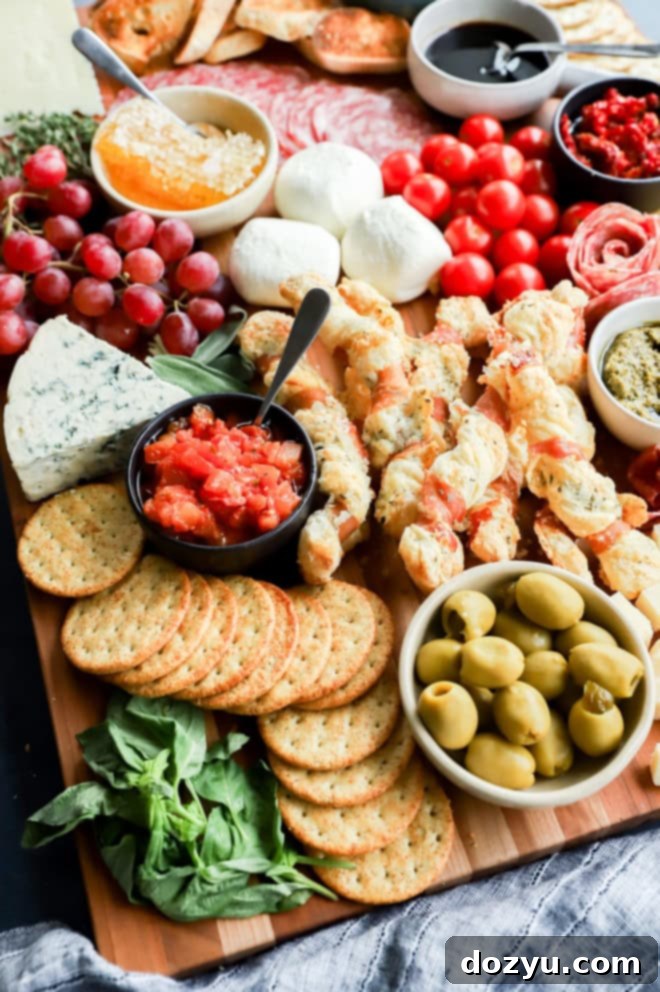
What to Serve with an Italian Charcuterie Board
An Italian charcuterie board is a meal in itself, particularly when served as an appetizer. With its rich variety of cheeses, savory cured meats, crunchy crackers, fresh fruits, and other delectable snacks, it’s often all you need to kick off a party or social gathering. Its diverse offerings mean you rarely need to pair it with another complex recipe.
However, the right beverage can elevate the experience, making each bite even more enjoyable. If you’re wondering what cocktail to serve, definitely lean towards something with an authentic Italian twist. Our top preference for pairing with a vibrant Italian charcuterie board is an aperitif, specifically Aperol. This bright orange, slightly bitter, and sweet Italian liqueur is incredibly refreshing and perfect for stimulating the appetite.
You have several delightful options for serving Aperol:
- Make a classic, bubbly Aperol Spritz, a popular choice that’s light and effervescent.
- Opt for a simpler Aperol Soda for a less sweet, equally refreshing drink.
- Experiment with an Aperol Sour for those who enjoy a tangier profile.
- For a more sophisticated and complex taste, try an Aperol Negroni, a lighter take on the classic Negroni.
If Aperol isn’t to your taste, or if you’re looking for another classic Italian spirit, consider a limoncello cocktail. This bright, zesty lemon liqueur offers a different, equally delicious pairing:
- A Limoncello Spritz is wonderfully refreshing and perfect for warm weather.
- A Limoncello Martini offers a stronger, more elegant citrus experience.
Beyond cocktails, a good Italian wine is always an excellent choice. A light-bodied red wine like a Dolcetto or a Chianti Classico would complement the cured meats beautifully. For white wine lovers, a crisp Vermentino or a sparkling Prosecco would provide a refreshing contrast to the rich cheeses.
Everyday Seasonal Cookbook
Unlock the full potential of fresh ingredients with our Everyday Seasonal Cookbook! Packed with insightful seasonal produce guides, delightful recipes, and practical tips, this cookbook is your go-to resource for creating delicious, seasonal food for every occasion, from casual weeknight dinners to elegant party spreads like this Italian charcuterie board.
More Italian-Themed Appetizers
If you’re looking to expand your Italian appetizer repertoire beyond the charcuterie board, these delightful recipes are sure to please:
- Caprese Bruschetta: A fresh and vibrant classic, made with juicy, ripe tomatoes, creamy fresh mozzarella, and aromatic basil, perfectly seasoned and served on toasted bread. It’s an easy and incredibly flavorful appetizer, especially when tomatoes are in peak season.
- Spicy Lasagna Dip: A hearty and comforting baked dip that transforms the flavors of lasagna into an irresistible appetizer. It’s rich, warm, and perfect for dipping toasted slices of crusty bread, sturdy crackers, or even fresh vegetables.
- Air Fryer Roasted Garlic Bread: Love the irresistible aroma and taste of garlic bread? This recipe makes perfectly crispy and garlicky bread in just minutes using your air fryer, making it a quick and easy side or appetizer.
- Marinated Olives: A simple yet sophisticated appetizer. Marinate a mix of your favorite olives (like Castelvetrano, Kalamata, and Cerignola) in olive oil, garlic, orange zest, and fresh herbs like rosemary and thyme.
- Arancini (Fried Risotto Balls): These crispy, golden-fried risotto balls are a delicious and impressive Italian snack, often filled with cheese, ragu, or vegetables.
Seasonal Tip
To truly enhance your Italian charcuterie board, always prioritize selecting seasonal produce that is perfectly ripe and bursting with flavor! The freshness of fruits and vegetables can make a significant difference. Refer to our comprehensive seasonal cooking quick start guide to find detailed lists of what’s in season each month. By choosing your favorite, in-season fruits and vegetables, you’ll ensure your board is not only visually stunning but also offers the very best taste experience possible!
Finally, if you make this ultimate Italian charcuterie board for your next gathering, please be sure to give this recipe a rating and/or leave a comment below! I absolutely love hearing about your culinary creations and always take the time to respond to every single comment. Your feedback is invaluable!
Feel free to drop any questions you might have about ingredients, assembly, or pairings below as well – I’m here to help you craft the perfect board!
Oh, and be sure to tag me on Instagram, Facebook, or Pinterest if you make the recipe! It brings me immense joy to see these recipes come to life in your homes – looking through those beautiful photos truly means the world to me!
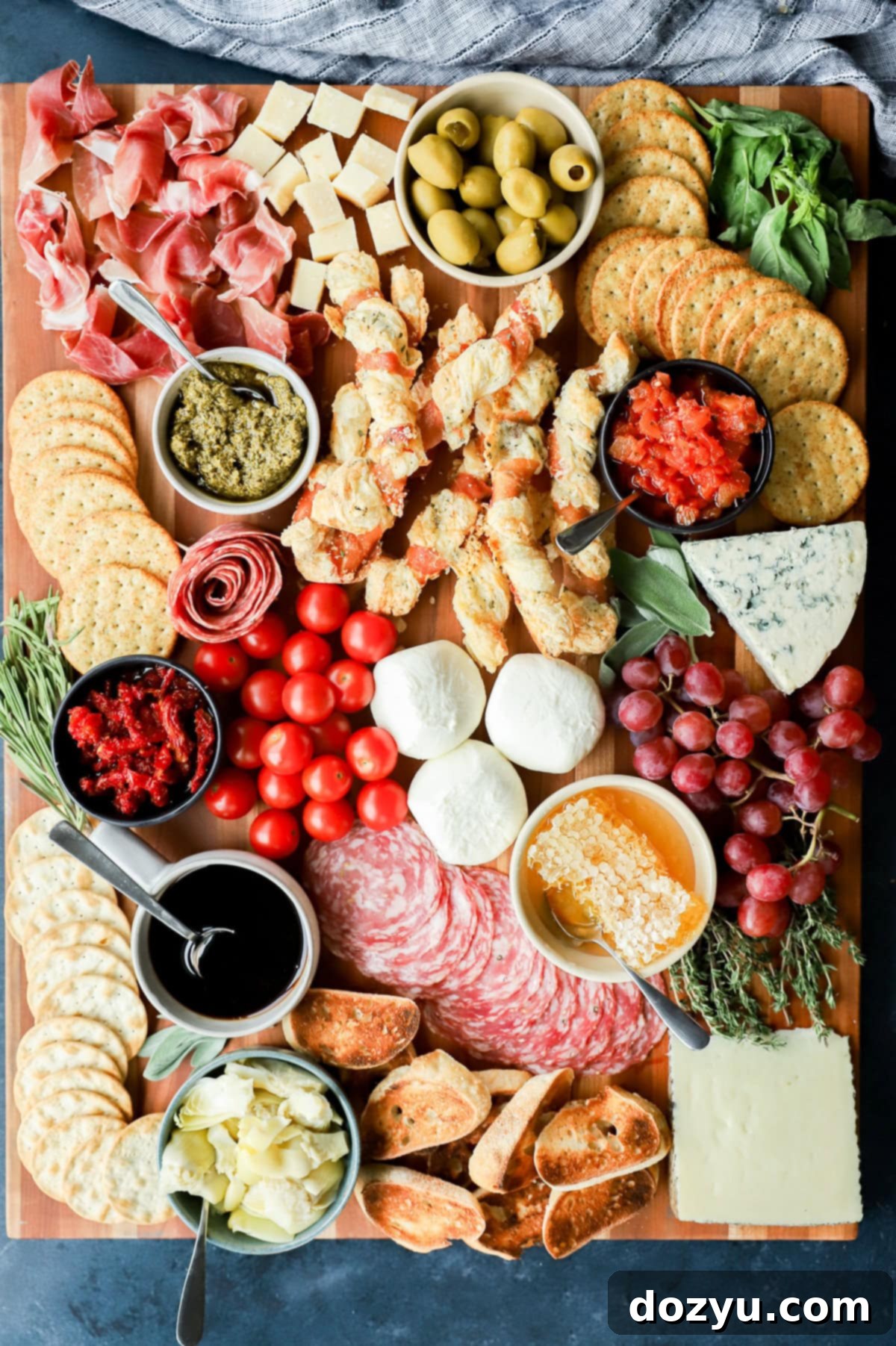
Italian Charcuterie Board Recipe
Ingredients for Your Board
- Burrata or Marinated Mozzarella balls (Bocconcini/Ciliegine) (approx. 4-6 oz)
- Parmigiano-Reggiano or Aged Pecorino Romano (approx. 4-6 oz, cut into rustic chunks or shavings)
- Whipped Ricotta cheese or Taleggio (approx. 4-6 oz)
- Gorgonzola (Dolce or Piccante) (approx. 4-6 oz, crumbled)
- Prosciutto di Parma or San Daniele (thinly sliced, approx. 4-6 oz)
- Salami (e.g., Genoa, Calabrese, Felino) (thinly sliced, approx. 4-6 oz)
- Soppressata or Coppa (thinly sliced, approx. 4-6 oz)
- Mortadella or Speck (thinly sliced, approx. 4-6 oz)
- Crackers (2-3 different types: water crackers, artisan crackers, taralli)
- Sliced Baguette (lightly toasted or fresh)
- Grissini (Italian Breadsticks)
- Seasonal Fruits (e.g., red grapes, sliced pears, figs, berries, apple wedges)
- Cherry Tomatoes (halved or whole)
- Assorted Olives (e.g., Castelvetrano, Kalamata, black olives in brine)
- Basil Pesto Sauce (homemade or high-quality store-bought)
- Sun-dried Tomatoes (oil-packed, drained)
- Fig Jam or Red Pepper Jelly
- Bruschetta Mixture (fresh tomato and basil topping)
- Marcona Almonds or Mixed Nuts
- Honeycomb or Local Honey
- Marinated Artichoke Hearts
- Balsamic Glaze (for drizzling)
- Fresh Herbs (basil, sage, oregano, thyme, rosemary sprigs)
Assembly Instructions
-
Prepare Ingredients: Before starting assembly, slice all meats and cheeses, wash and pat dry fruits/vegetables, and gather all bowls and serving utensils.
-
Place Bowls: Start by arranging your small bowls for wet items (olives, jams, pesto, honey) on your serving board. Evenly space them out to create a balanced foundation.
-
Add Meats: Artfully arrange the cured meats in sections. Fold prosciutto into ribbons, fan out salami slices, and distribute them around the bowls. Create visual appeal by varying textures and shapes.
-
Incorporate Cheeses: Place your prepared cheeses next. Arrange hard cheeses in chunks or slices, crumble blue cheeses, and position soft cheeses for easy access. Ensure a cheese knife is available for wedges.
-
Add Crackers & Bread: Create clusters of crackers, sliced baguette, and breadsticks in various spots on the board, near the cheeses and meats.
-
Include Fresh Elements: Fill in remaining larger spaces with seasonal fruits (grapes, pears, figs) and fresh vegetables (cherry tomatoes). Use them to add color and refreshing balance.
-
Fill with Extras: Tuck in smaller extras like nuts, sun-dried tomatoes, and any other condiments into smaller gaps, making the board look abundant.
-
Garnish with Herbs: Finally, tuck sprigs of fresh herbs (basil, rosemary, thyme) into any remaining empty spaces for decoration and aromatic appeal. Add small spoons to jams/compotes/honey.
Video Guide
